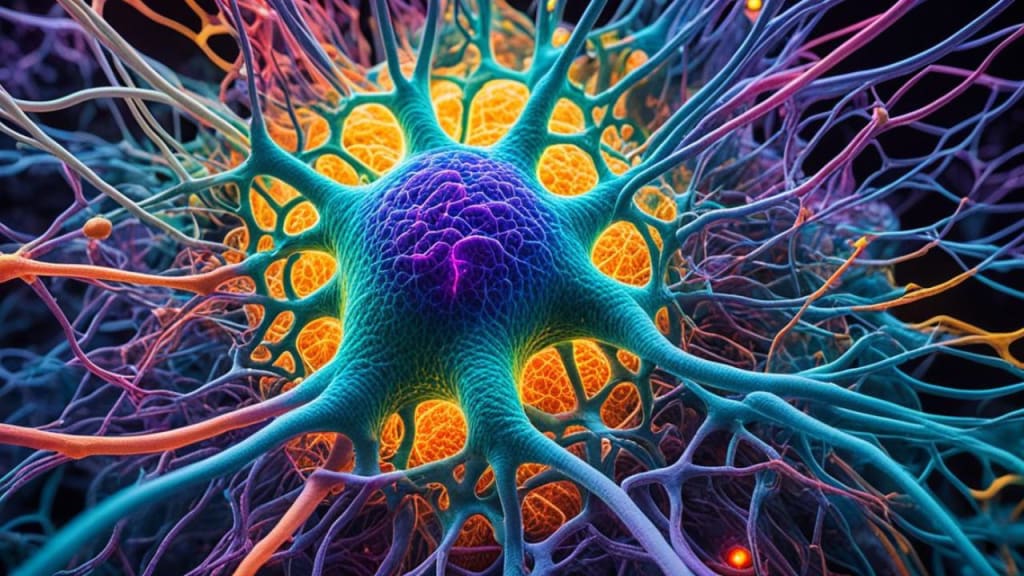How Life Experiences Influence the Activity of the Brain's Cellular Powerhouses
Understanding the Impact of Personal History on Mitochondrial Function in the Brain

The human brain is amazing. It adapts as we go through life's ups and downs. Neuroscience has shown how our experiences affect our brain's structure and function. We'll explore how mitochondria, the brain's powerhouses, help with this adaptation and growth.
Neuroplasticity, the brain's ability to change, has fascinated experts for some time. Our experiences shape how our brains work. Whether it's learning something new or dealing with a tough time, each experience changes our brain's wiring.
Mitochondria are key to this process. They're like power plants in brain cells, driving our mental activities. Studies show how things like exercise and socializing influence mitochondria. This affects how our brains are set up and how they work.
Key Takeaways
The brain can adapt to life's experiences because of neuroplasticity.
Mitochondria in brain cells are very important for the brain's health.
Things like physical activity and who we spend time with can change how mitochondria work in our brains.
Learning about how our experiences and mitochondria interact can teach us about brain development and mental health.
Scientists are still studying how the brain, its parts, and our experiences come together.
Unraveling the Mysteries of Neuroplasticity
The human brain is amazing, always changing in response to what we go through. This is called neuroplasticity. It's key to how we think and interact with the world around us.
Neuroplasticity: The Brain's Remarkable Ability to Adapt
Neuroplasticity is the brain's power to adapt and change its structure and function. It's never fixed but always evolving. The brain can make new connections, make strong old ones, and even get rid of the ones it doesn't need.
This way, it can face new obstacles, learn new things, and heal from injuries or trauma.
Environmental Factors Shaping Neural Pathways
Our experiences and where we live greatly shape our brains and how we think. Things like going to school, being with friends, and the things we choose to do all have a big impact. For instance, if you learn to play music or a new language, your brain makes new connections.
Being around lots of different things and chances to learn makes our brains more complex. On the flip side, stress, being alone, and other bad experiences can stop our brains from changing and adapting.
Learning how our environment affects our brain can tell us a lot about how we think. With these insights, we see the big picture of how our minds and experiences are tied together.
https://youtube.com/watch?v=LNHBMFCzznE
Studies Relate Life Experiences to Brain Structure
Neuroscience and psychology are interested in how our lives shape our brains. They show that the things we go through change parts of our brains. These changes include differences in brain size, how dense brain areas are, and which parts are connected.
A Journal of Neuroscience study revealed that those facing trauma saw changes in the amygdala. This area deals with our emotions. The study found the amygdala might get smaller. So, tough life events could physically alter our brains.
"The brain has a remarkable ability to adapt and change in response to our experiences, a phenomenon known as neuroplasticity."
Education and rich environments can also change your brain for the better. Brain areas for smart thinking can get thicker by doing mind-stretching tasks. This shows how learning and living in interesting places can boost our brains.
These connections show how our outside world can change what's happening inside our heads. Knowing this helps experts find new ways to help with thinking and mood problems. It leads to treatments that are more about you, making them work better.
Trauma and the Amygdala
Reduced volume of the amygdala in individuals who experienced traumatic events
Underscores the impact of life experiences on brain anatomy and emotional processing
Education and Cortical Thickness
Increased thickness of the cerebral cortex in individuals engaged in intellectually stimulating activities
Highlights the brain's remarkable ability to adapt and change in response to environmental factors
This study highlights the deep link between our life stories and our brain shape. It opens doors to better ways to grow our thinking, get stronger emotionally, and keep our brains healthy overall.
The Role of Epigenetics in Cognitive Development
The human brain is always changing, influenced by what we do and experience. Epigenetics shows us how our surroundings and choices can change how our genes work, even without changing the genes themselves. This area of study helps us see how our genes and our life experiences work together to shape our minds.
Epigenetic Mechanisms and Brain Anatomy
DNA methylation and histone modifications are important in how genes are activated in the brain. Things like stress, the food we eat, and how we interact with others can change these markers. When these changes happen, they can affect how our brain works and how we think and behave.
Bad experiences in childhood can cause changes that impact brain regions important for decision-making and emotional control. These changes can last a long time and may lead to mental health issues in the future.
On the other hand, good experiences like exercise or mindfulness can improve how our brains work. These activities can lead to positive changes in our genes, helping our brain function better. This gives hope for new treatments to support our thinking and emotional health when faced with life’s difficulties.
"Epigenetics is the study of how your behaviours and environment can cause changes that affect the way your genes work. Unlike genetic changes, epigenetic changes are reversible and do not change your DNA sequence, but they can change how your body reads a DNA sequence."
The science of epigenetics is always growing, offering insights into how our genes and lives interact to influence our minds. Insights from this field might lead to new ways to keep our brains healthy and improve how we think about our lives.
Environmental Influences on Brain Anatomy
The human brain is constantly affected by the world around us. Things like stress and daily choices shape our brains. This can lead to big changes in how our brain works and its structure.
Stress is one major influence on brain anatomy. It can make the hippocampus, the key to memory and emotions, smaller. But, activities like meditation can grow parts of our brain that handle attention and feelings.
Eating right is vital for our brains. Foods with omega-3 and other nutrients help our brains grow and connect better. On the other hand, junk food can harm our brains and how well we think.
Moving our bodies is also great for the brain. Exercise can make our memory and thinking better by growing parts like the hippocampus and prefrontal cortex. This leads to a sharper mind and a feeling of good.
Our interactions with others also shape our brains. Good relationships help parts of our brain that understand others and control emotions to grow. Yet, if we're often alone or face tough times, it can change our brains in ways that are negative for our mental health.
Our brain is very adaptable. It can change a lot depending on our surroundings. So, knowing how to keep our brains healthy through our choices is key. This not only helps our brains but our whole well-being.
Environmental Factor
Effect on Brain Anatomy
Stress
Reduced volume of the hippocampus
Nutrition
Increased volume and connectivity in regions involved in learning, memory, and cognitive control
Physical Activity
Increased size of the hippocampus and prefrontal cortex
Social Interactions and Emotional Experiences
Increased volume and connectivity in regions associated with empathy, social cognition, and emotional regulation
Research shows just how powerful our surroundings are in shaping our brains. With this knowledge, we can create spaces that boost brain health and thinking. This way, we can unlock our full potential.
Conclusion
This deep dive has shown us how our experiences shape our brain's ability to change. The research we've looked at shows how the brain can adjust its structure and function. It does this in response to what we experience, which scientists call neuroplasticity.
We've explored how our genes and the world around us work together to affect our brains. This understanding is key in neuroscience, psychology, and learning how our minds work. It shows how important our experiences are to our brain's growth and our thinking skills.
Diving into the brain's mysteries has given us valuable new insights. These findings will help improve how we understand and treat brain-related issues. And, they will guide future studies in helping us learn more about our brain's incredible ability to change.
FAQ
What is the relationship between life experiences and brain structure?
Studies show that our experiences can change how our brains work and grow. Our brains can adapt and make new connections. This happens because of its ability to reorganize itself based on what we encounter in life.
How does neuroplasticity work?
Neuroplasticity is the brain's way of changing and evolving. It creates new connections and strengthens old ones. At the same time, it gets rid of ones we don't need.
This happens because the brain changes in size, density, and how different parts connect. It's all in response to the things we go through and learn in life.
What role do environmental factors play in shaping the brain's structure?
Our surroundings and what we do can greatly affect how our brain is structured. Things like learning, being with others, moving our bodies, and the choices we make can make our brains change. This can change the size, connections, and density of different parts of our brain.
How do epigenetic mechanisms contribute to cognitive development?
Epigenetic mechanisms can change how our genes work without changing the genes themselves. They can have a big impact on how our brain grows and works. They do this in response to the things we go through and the world around us.
What are the specific ways in which the environment can influence brain anatomy?
Things like stress, what we eat, moving our bodies, and being with others can make the brain change. This affects the size, connections, and how dense different brain parts are. Our surroundings play a big role in how our brain grows and works.
About the Creator
Enjoyed the story? Support the Creator.
Subscribe for free to receive all their stories in your feed. You could also pledge your support or give them a one-off tip, letting them know you appreciate their work.





Comments (1)
Hey, nice amass of ideas.